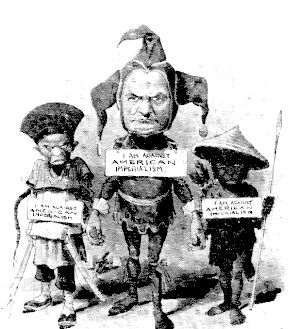Chapter 1: The Anti-Imperialist League 1898-1902
Pages 3 - 4
Chapter 2: The People's Council 1917-1919
Pages 5 - 6 - 7
Chapter 3: The American League Against War and Fascism and the Emergency Peace Campaign 1933-1939
Pages 8 - 9 - 10
Chapter 4: The Progressive Citizens of America 1946-1948
Pages 11-12
Chapter 5: The "Mobes" against the Vietnam War 1966-1970
Pages 13-14
Chapter 6: The Nuclear Freeze Movement and People-to-People Diplomacy 1980-1990
Pages 15-16-17-18
Chapter 7: Global Movement for a Culture of Peace 2000-
Pages 19-20-21
Chapter 8: The Root Causes of War
Pages 22-23-24-25-26-27
Chapter 9: The Future of the Peace Movement
Pages 28-29-30-31
Acknowledgements
Page 37
The United States was rather late among the great capitalist powers to begin establishing a colonial empire. It wasn't until the 1890'S that the U.S. went beyond seizing or buying adjacent land from Mexico or Canada and began to seek an overseas empire.
The Spanish-American War and the U.S. colonial seizure of the Philippines led to the greatest American anti-war movement up until that time, the Anti-Imperialist League (Note 1). As DeBenedetti's history of the peace movement describes, "The eruption of the Filipino-American War transformed the Anti-Imperialist League into a national movement with a mass constituency. Working with other anti-imperialist elements, League membership expanded to over 30,000 in a growth spurt that made it the largest antiwar organization per capita in American history."
The growth of the Anti-Imperialist League from a small group of intellectuals and businessmen in Boston to a large nationwide movement was a reaction to the mounting casualties in the Philippine War. The war with Spain had . been rather brief and had relatively few casualties, but the Philippine War was bloodier (the Filipinos lost up to 600,000 dead). By the spring of 1899, letters were arriving in the U.S. from American troops indicating that casualties were much greater than what the government and newspapers were willing to admit. The Boston movement spread to the rest of the country as people demanded that American troops be brought home.
As indicated by its name, the Anti-Imperialist League specifically opposed the new American policy of imperialism which sought to obtain part of the overseas empires being divided up by Europe and Japan. The League's program, as described by DeBenedetti, "defended the country's traditional commitments to political unilateralism, military independence, and exemplary moral conduct, [and] maintained that overseas conquest would do nothing but subvert America's unique experiment in constitutional republicanism."
| Figure 1. Racist lampoon of the Bryan Presidential campaign - 1900 | 
|
Anti-war sentiment against the Philippine war was channeled into the Presidential candidacy of William Jennings Bryan in the election of 1900. Under pressure from the Anti-Imperialist League Bryan agreed that a declaration should be inserted in the party platform that imperialism was the "paramount" issue of the campaign, and he devoted his acceptance speech for the Democratic nomination to that issue.
(continued on next page)
 |
 |
 |